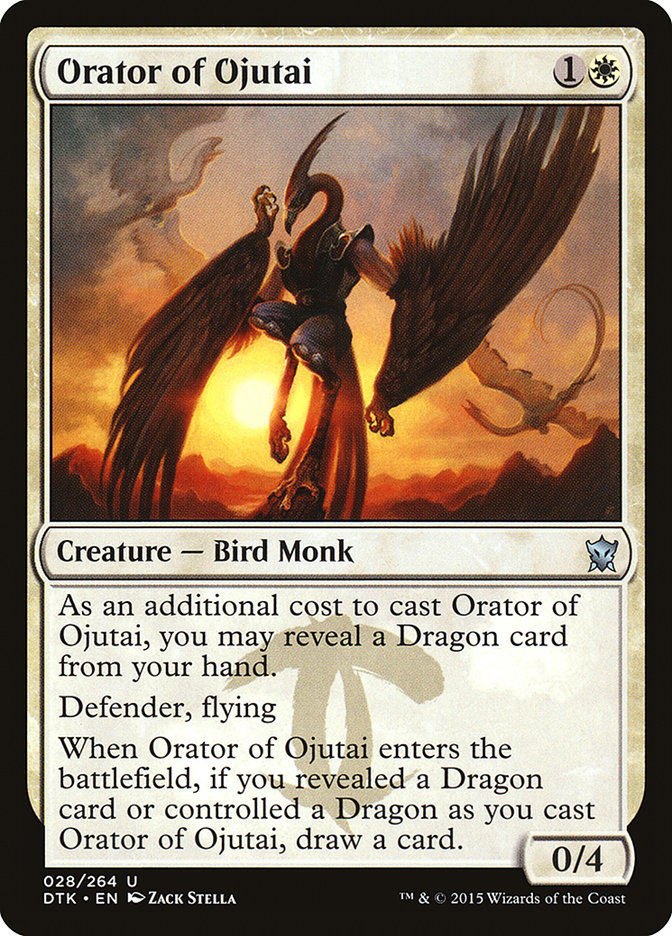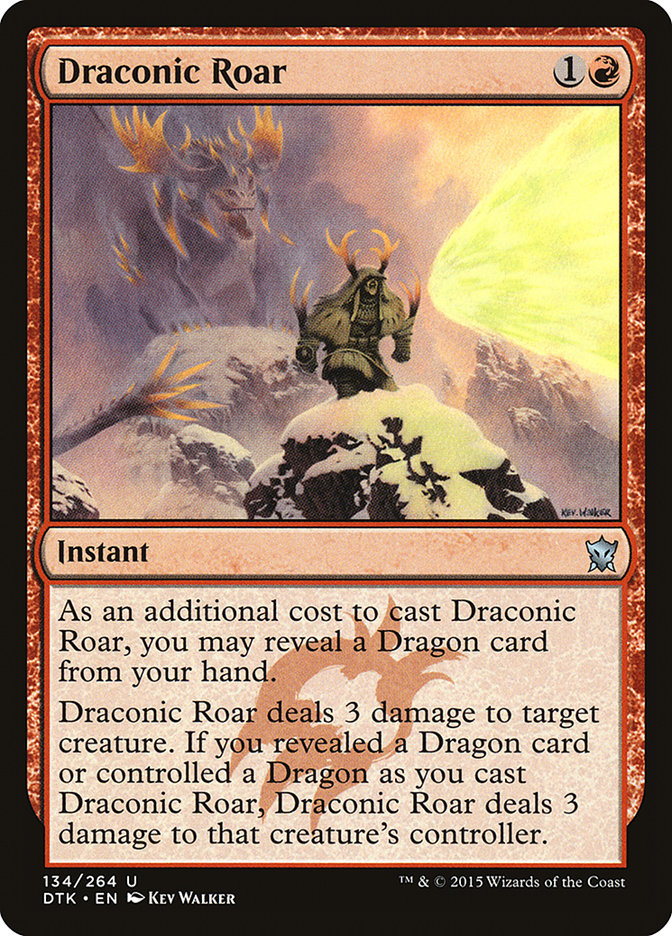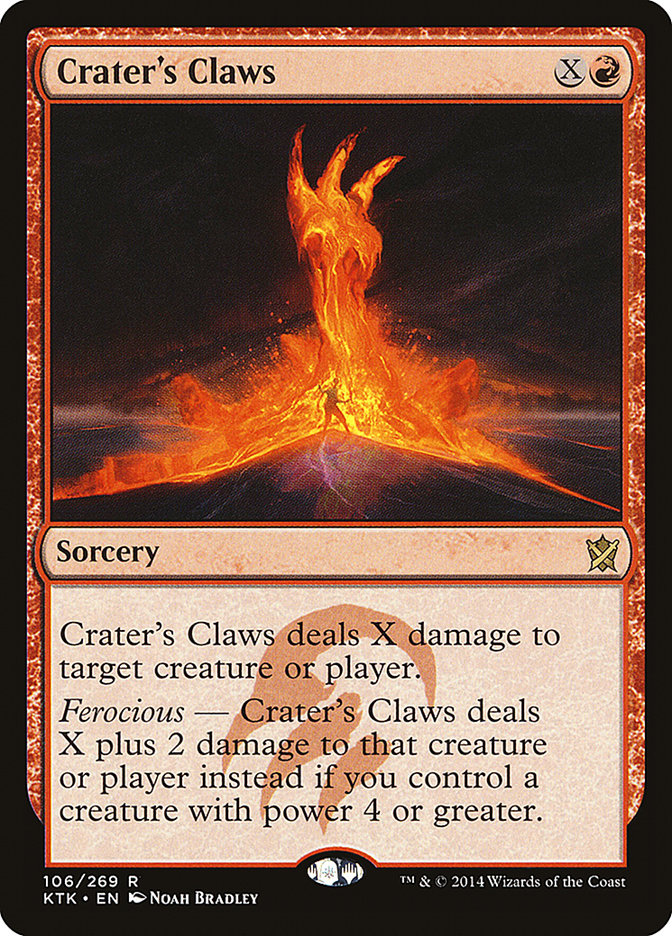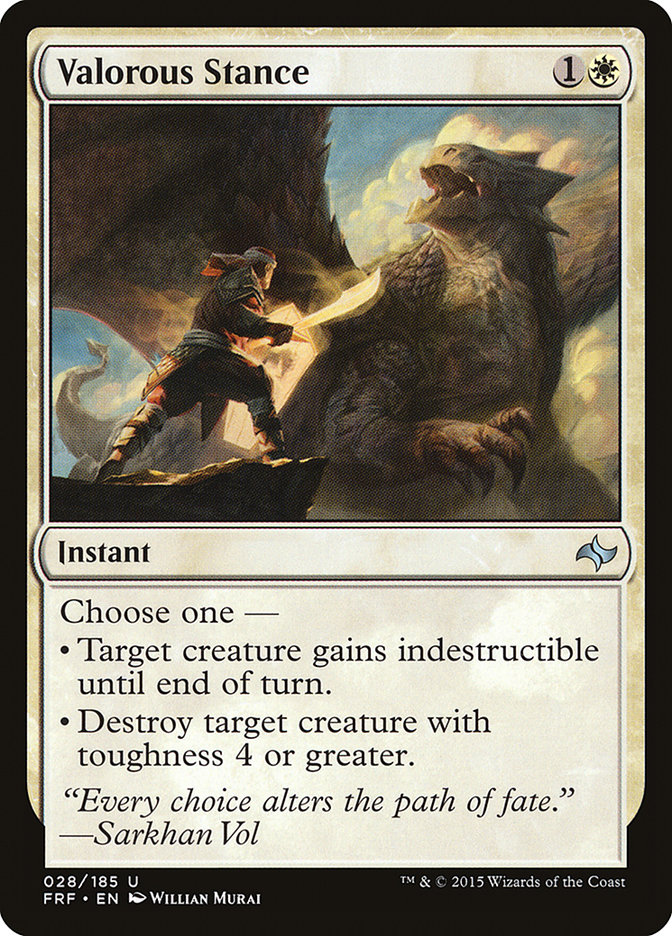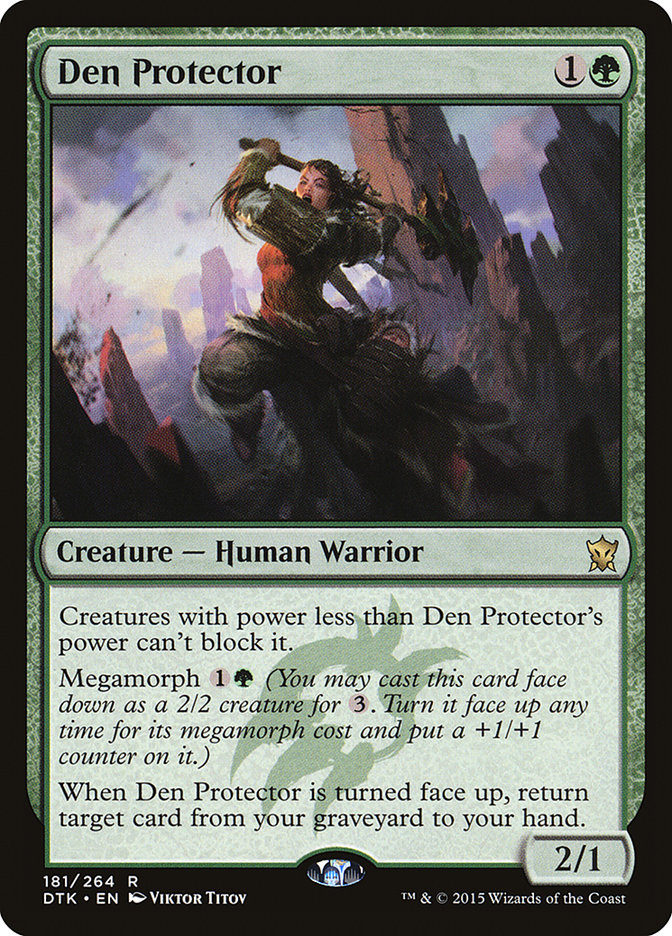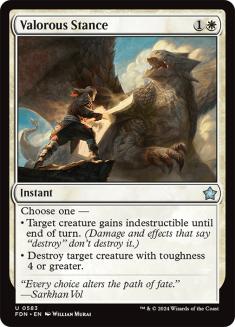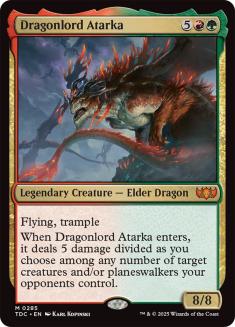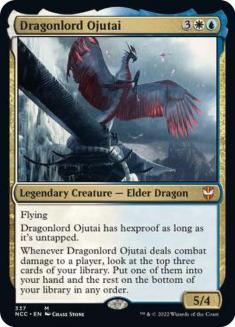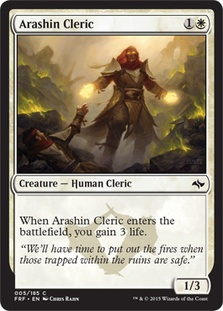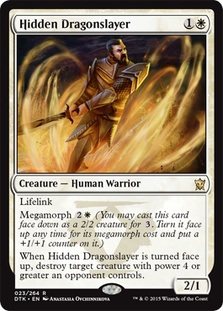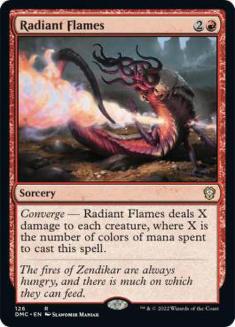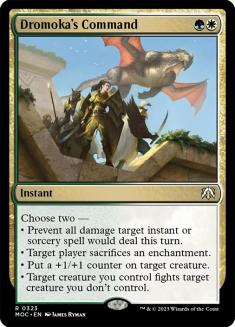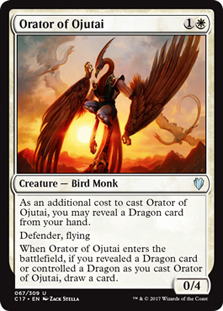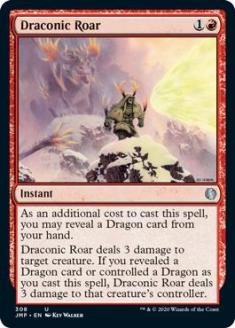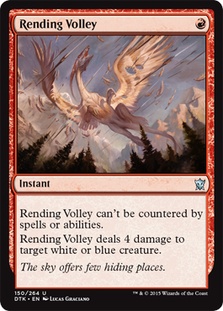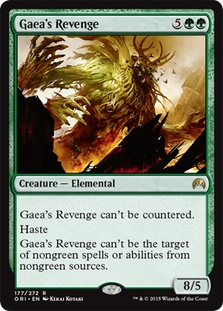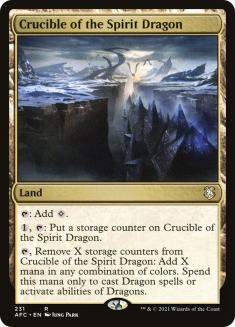This weekend will mark the first time Battle For Zendikar will be legal in Standard, and everyone will have to say their goodbyes to M15
and Theros block. By now I’m sure most of you have started to build new decks and have thoroughly looked through the spoiler and perhaps attended
your local Prereleases.
This is the deck that I’ve focused the most time on developing. It may look like it was put together in five minutes by the number of four-ofs present, but
it went through many iterations before getting to this point. My path to get here started something like this:
The Path of the Dragonlords
It began with developing Mono-Green Eldrazi Ramp early on in the
spoiler season before the complete set was known. The hope was that we’d get a good two-drop accelerant like Rampant Growth or Explore but instead only got
Beastcaller Savant, which was both fragile and limited the number of non-creature spells a deck could play. Expensive spells like See the Unwritten and
Ugin, the Spirit Dragon simply didn’t work alongside Beastcaller Savant and the deck felt like an inefficient mess. The fact that Oblivion Sower worked
poorly with the fetchlands it got made it worse than expected as well.
The deck needed some form of interaction, preferable in creature form, and Dragonlord Atarka seemed like the best payoff creature to ramp into. I played a G/R version for a while, and it was indeed better, but it sucked
that it didn’t have any form of lifegain and that the six-drop options weren’t very good. Oblivion Sower still suffered from the same problems, even though
it now got Mountains with fetchlands; Conduit of Ruin had to live for a turn to be relevant; and Greenwarden of Murasa wasn’t good because your cards
either didn’t go to the graveyard or you brought back a largely useless piece like an early accelerant that died or a Wooded Foothills.
With the fetchlands plus Battle land manabase, it was easy to play a Canopy Vista and Dragonlord Atarka and then I started working on Naya Dragons. The deck was better and the mana worked well most of the
time, but it was still without enough testing and ran too many basic Forests and not enough red sources leaving Draconic Roar or red sideboard cards stuck
in hand at times. Whisperwood Elemental was the five-drop of choice, and while it’s undeniably an excellent Magic card, all it did was gum up the ground
which the deck already did reasonably well (gumming the ground isn’t good against a Hangarback Walker metagame by the way). The Beastcaller Savants did a
reasonable impression of a decent mana accelerant when they found their way onto the battlefield on turn 2, but were miserable topdecks anytime afterwards.
The deck needed to find a better two-drop.
Then this little birdy came a’knockin.
Wall of Omens was a great card. It stalled long enough for a deck to fulfill its bigger gameplan. The problem with Orator of Ojutai is that unlike Draconic
Roar, Silumgar’s Scorn, and Foul-Tongue Invocation it really, really, needs its Dragon clause to be met to be a playable card.
The Dragon decks of this past Standard season had had anywhere from six to ten Dragons in them to hit the bonuses of the played Dragon spells. Frank
Karsten wrote an article in March that
explained the math of Orator of Ojutai to an understandable level for the public. With ten Dragons, the odds of having one on turn 2 with Orator of Ojutai
was roughly 80%. With sixteen Dragons that jumps to 94%, which is more than acceptable.
At worst, Orator of Ojutai will cycle for two mana. At second-worst, it will gain you four life as well. At best, it will blank something awesome like a
Mantis Rider while leaving you net-neutral on cards. Sometimes people are trying to get your big creature with Foul-tongue Invocation or Self-Inflicted
Wound, and Orator of Ojutai steps in to take one for the team. All-in-all this adds up to a strong card that I’m always happy to have in my opening hand,
even in multiples. This Dragonlord deck will be playing the control role more often than not, and extending the game by solving the small rush threats will
be key to many matchups.
Without further ado, this is the list I’ve worked up for #SCGIndy:
Creatures (28)
- 4 Rattleclaw Mystic
- 4 Shaman of Forgotten Ways
- 4 Dragonlord Atarka
- 4 Thunderbreak Regent
- 4 Dragonlord Dromoka
- 4 Dragonlord Ojutai
- 4 Orator of Ojutai
Lands (25)
Spells (7)

The Manabase
It’s funny how simple the mana looks with all the four-ofs and how long it took me to get to it. I think that the future of manabases and likewise the
spells included in Standard Constructed decks will start to follow what’s optimal mana-wise instead of trying to fit a manabase to accommodate the spells
that you want to play.
Yeah, that was a lot to follow…
What I mean is that with a mostly three-color deck like this Dragonlord deck, you want to play 3-4 basic lands, eight fetchlands, and eight Battle lands
along with four lands that “do stuff,” which will most likely be creature-lands. Though there are only Shambling Vent and Lumbering Falls now, every deck
will have even more complicated manabase building options in three months.
Any hand that has two of any twelve of the eight fetchlands and four basics will want to lead on getting two basic lands onto the battlefield first. Hands
that don’t will want to lead on a tapped Battle lands and play untapped lands from there for a while until they eventually find two basics to start playing
Battle lands untapped in the later turns.
Decks that want one-drops obviously throw this plan for a curve (or literally out of curve), and I think that’s an inherent flaw in the deck’s design.
Rather than trying to relentlessly tweak a deck’s mana to optimize everything from one- to five-drops, I’m playing a deck that maximizes what I feel is the
sweet spot for a manabase to be.
The Creatures
A lot of four-ofs of and a lot of legendary creatures. The basic theory is that the Dragonlords are so powerful that they become the focus of whatever game
you’re in. Either they die or your opponent does and they’re powerful enough on the battlefield that you don’t mind having an extra copy in hand. It also
overloads their removal. For example, it’s common to play a Dragonlord Dromoka and have it get Abzan Charmed then follow up with another that ends up going
uncontested, at least long enough to stabilize.
The Dragon curve is natural, starting with Thunderbreak Regent at four and finishing at Dragonlord Atarka at seven. The wombo combo of the deck is to play
Dragonlord Ojutai then follow up with Dragonlord Dromoka after they’ve left up mana to kill Ojutai when you attack. This ensures a clean hit that leaves
them between a rock and a hard place deciding which fat Dragon to kill on their turn. While they wince and cringe, you’re flicking around the Dragonlord
Atarka that’s getting slammed next turn.
Rattleclaw Mystic and Shaman of Forgotten Ways are the best accelerants. I wish there was at least one more good one, but sadly the bodies and general
nut-lowness associated with Whisperer of the Wilds and Beastcaller Savant just aren’t doing it for me. Thankfully, Orator of Ojutai helps to pick up the
slack. Delaying the game a turn is not so dissimilar to being a turn faster.
The Spells
The removal spells are all conditionals in one way or another, and much of the sideboard is dedicated to smoothing out your removal suite. Draconic Roar is
obviously a good card in a deck with sixteen Dragons, but the three extra damage won’t actually be relevant in most games you play. It’s closer to an
instant-speed Reave Soul than a six damage powerhouse like it previously was. Valorous Stance is for the bigger midrange things like Siege Rhino and
Anafenza, the Foremost. Sometimes you get to save a Dragon from a non-exile removal spell, which is pretty nice as well. Crater’s Claws is a good finisher
that scales well with the ramp nature of the deck. It’s common to have a spare mana when you cast a Thunderbreak Regent or Dragonlord Ojutai, which is a
prime time to fire off Crater’s Claws as a Shock on a smaller creature to create a huge tempo advantage.
A Couple Near Misses
This card was once tried and found to not be effective enough. As a lategame topdeck, it’s bad and it’s rare that you have multiple Dragons out to start
dealing more than one damage at a time to kill bigger creatures. With that said, those decks didn’t run as many Dragons and the format was faster than what
I assume will be at #SCGindy. I think Dragon Tempest is best against a deck with one-toughness creatures that aren’t beating you down, like Lightning
Berserker or Hordeling Outburst tokens, but rather are utility creatures like opposing Rattleclaw Mystics. I had one copy of Dragon Tempest in the maindeck
for a while before moving it to the sideboard, then ultimately cutting it altogether. While I’m not currently running Dragon Tempest, I consider it to be a
powerful card for a Dragon deck that I’ll be keeping in mind for the future with this deck.
Your deck wants to slam game-winning threats early and often. While you play some amount of interaction, you still want to stick to that tap-out primary
plan. The body of Den Protector doesn’t really add up to your gameplan, and you rarely have something you want to get when you have Den Protector “on
time,” which is on five mana. You’re designed to do bigger and better things, and even after sideboard when things can get grindy, I’ve found Den Protector
to be underwhelming. We have Haven of the Spirit Dragon for our rebuying needs.
The Sideboard
You’ll wait to customize your removal spells after sideboard, so a decent amount of the sideboard is dedicated to that. Non-creatures spells also need to
be cheap, as sideboard games usually involve your Rattleclaw Mystics dying more often, and Shaman of Forgotten Ways won’t help. Creatures are good to go
though. Arashin Cleric is great against aggressive decks, Mono-Red in particular. Hidden Dragonslayer serves as anti-aggro defense and big creature killer
all in one. Gaea’s Revenge are for against the counterspell decks, as is the Crucible of the Spirit Dragon. When your mana creatures run the risk of
getting swept up, you want a 26th land.
Mini-Sideboarding Guide
Of course the metagame hasn’t been established yet, but we can reasonably expect the already existing archetypes to somewhat transfer over through the set
rotation. Here’s how I would sideboard against a few of the decks that I anticipate on facing at #SCGIndy.
VS Mono-Red/Atarka Red
Out:
In:
VS Eldrazi Ramp
Out:
In:
VS Blue-Based Control
Out:
In:
VS Abzan
Out:
In:
VS Jeskai Aggro
Out:
In:
Wait, If This Deck Is So Good, Why Haven’t We Seen It Yet?
You’ve probably noticed that the maindeck doesn’t run any cards from Battle For Zendikar other than Battle lands. It’s true that this archetype
has existed this whole time. So the question is: If it’s been here this whole time and hasn’t been putting up tournament results, why is it suddenly so
good? Here’s why.
The mana simply wasn’t there. The Temples always entered the battlefield tapped, as did the tri-lands. Often you’d need the sixth or seventh mana to be
untapped, and you wouldn’t get it in time. The mana concerns made it tough to pair Thunderbreak Regent and Dragonlord Ojutai together without playing pure
Jeskai, which to its credit, did win one of the last Open Series events this year at the Season Three Invitational. But it never had good enough mana for
four colors with a strong base of green for acceleration.
Elspeth, Sun’s Champion was another big problem. Getting your board swept happens, but when it comes with a planeswalker attached that wins the game on its
own, Dragonlords are in a tough spot. Oh and everyone and their mom was running her too. Still though, Ali Aintrazi won with Naya Dragons at the Season Two
Invitational, proving that Dragon ramp can succeed even under very tough conditions (just not flap around happily frivolously).
Why Play This Deck?
It’s proactive, powerful, and very easy to play. The mana feels good, and it feels like it’s running the best Dragons available. It’s closer to G/R Tron
from Modern than G/R Devotion from last Standard season. There’s not a ton of “play” to it, and your wins will usually be by landslides. While I typically
like to win through finesse with decks like Infect or by exactisies with something like Boss Sligh, there’s no denying the potency of raw power. For week
one, I want to be the one with the huge threats that have to be answered and bank on the opposition not having the tools to fight back.
Why Not to Play This Deck:
Enemy number one is Languish. The deck is soft to it, and I haven’t really fleshed out possible solutions to it. Right now I have Gideon, Ally of Zendikar
in mind, both for its repeatable threat source and for its emblem to push Thunderbreak Regent and Dragonlord Ojutai to five toughness. Right now there are
twelve sources of white so it’s feasible, but I’m skittish on it. Others are Retreat of Kazandu for the +1/+1 counter while still functioning as lifegain
against aggro or to find a way to stretch the mana to play more blue for Disdainful Stroke. Perhaps in the next couple of days before #SCGIndy, I’ll have
it figured out. Still, every deck will have a weakness one way or another, and trying to beat everything at once 100% of the time tends to spread a deck so
thin that it has trouble winning any matchup at all.
Conclusion
Dragonlords are sweet. My plan is straightforward: to jam Dragons down my opponent’s throat until they break. It often only takes one and I’ve got sixteen
of them. They’re just so pushed for their manacosts that it’s hard to not just play a bunch of mythic Dragonlords and hope they’re good enough. The signs
are telling me that they are. Here’s hoping they will be in Indianapolis!

